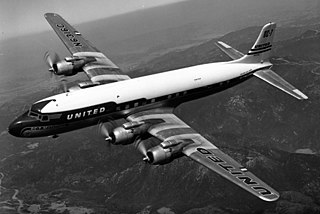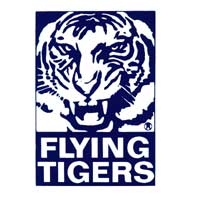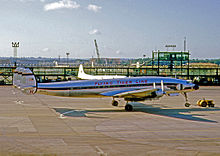
The Douglas C-54 Skymaster is a four-engined transport aircraft used by the United States Army Air Forces in World War II and the Korean War. Like the Douglas C-47 Skytrain derived from the DC-3, the C-54 Skymaster was derived from a civilian airliner, the Douglas DC-4. Besides transport of cargo, the C-54 also carried presidents, prime ministers, and military staff. Dozens of variants of the C-54 were employed in a wide variety of non-combat roles such as air-sea rescue, scientific and military research, and missile tracking and recovery. During the Berlin Airlift it hauled coal and food supplies to West Berlin. After the Korean War it continued to be used for military and civilian uses by more than 30 countries. It was one of the first aircraft to carry the President of the United States, the first being President Franklin D. Roosevelt during World War II.

The Douglas DC-7 is an American transport aircraft built by the Douglas Aircraft Company from 1953 to 1958. A derivative of the DC-6, it was the last major piston engine-powered transport made by Douglas, being developed shortly after the earliest jet airliner—the de Havilland Comet—entered service and only a few years before the jet-powered Douglas DC-8 first flew in 1958. Unlike other aircraft in Douglas's line of propeller-driven aircraft, no examples remain in service in the present day, as compared to the far more successful DC-3 and DC-6.
This is a list of aviation-related events from 1954:
This is a list of aviation-related events from 1979.
This is a list of aviation-related events from 2000.

Flying Tiger Line, also known as Flying Tigers, was the first scheduled cargo airline in the United States and a major military charter operator during the Cold War era for both cargo and personnel. The airline was bought by Federal Express in 1988.

Flying Tiger Line Flight 739 (FT739/FTL739) was a Lockheed L-1049 Super Constellation propliner that disappeared on March 16, 1962, over the western Pacific Ocean. The aircraft, which had been chartered by the United States Army, was transporting ninety-six military passengers from Travis Air Force Base in California to Tan Son Nhut International Airport in Saigon, South Vietnam. After refueling at Andersen Air Force Base in Guam, the Super Constellation disappeared while en route to Clark Air Base in the Philippines. All 107 aboard were declared missing and presumed dead.

Air Midwest Flight 5481 was a Beechcraft 1900D on a regularly scheduled passenger flight from Charlotte Douglas International Airport in Charlotte, North Carolina, to Greenville–Spartanburg International Airport in Greer, South Carolina. On the morning of January 8, 2003, the Beechcraft stalled while departing Charlotte Douglas International Airport and crashed into an aircraft hangar, killing all 21 passengers and crew aboard and injuring one person on the ground.

Eastern Air Lines Flight 663 was a domestic passenger flight from Boston, Massachusetts, to Atlanta, Georgia, with scheduled stopovers at John F. Kennedy International Airport, New York; Richmond, Virginia; Charlotte, North Carolina; and Greenville, South Carolina. On the night of February 8, 1965, the aircraft serving the flight, a Douglas DC-7, crashed near Jones Beach State Park, New York, just after taking off from JFK Airport. All 79 passengers and five crew aboard perished.

Northeast Airlines Flight 823 was a scheduled flight from New York City's LaGuardia Airport to Miami International Airport, Florida, which crashed shortly after takeoff on February 1, 1957. The aircraft operating the service was a Douglas DC-6 four-engined propeller airliner, registration N34954, which entered service in 1955.
Aerosucre S.A. is a cargo airline based in Bogotá, Colombia. It began operation in 1969, and operates scheduled international and domestic cargo services throughout Latin America and the Caribbean. Its home base is El Dorado International Airport, Bogotá. Aerosucre has been involved in a number of accidents and incidents during its lifetime, and more recently, internet videos have emerged showcasing reckless behavior by its pilots.

Pacific Air Lines Flight 773 was a Fairchild F27A Friendship airliner that crashed on May 7, 1964, near Danville, California, a suburb east of Oakland. The Thursday morning crash was most likely the first instance in the United States of an airliner's pilots being shot by a passenger as part of a mass murder–suicide. Francisco Paula Gonzales, 27, shot both pilots before turning the gun on himself, causing the plane to crash, killing all 44 aboard.
The article describes accidents and incidents on Korean Air and its predecessor companies Korean National Airlines and KAL.

Northwest Orient Airlines Flight 2 was a Boeing 377 Stratocruiser aircraft that was ditched into Puget Sound, just off Maury Island at the Point Robinson Light, shortly after takeoff from Seattle-Tacoma International Airport (Sea-Tac) on the morning of Monday, April 2, 1956.

Pan Am Flight 7 was a westbound round-the-world flight operated by Pan American World Airways. On November 8, 1957, the Boeing 377 Stratocruiser 10-29 serving the flight, named Clipper Romance of the Skies, crashed in the Pacific Ocean enroute to Honolulu International Airport from San Francisco. The crash killed all 36 passengers and 8 crew members.

Pan Am Flight 923 was a Douglas DC-4 operating from Seattle, Washington to Juneau, Alaska, which crashed into Tamgas Mountain on Annette Island, Alaska, on October 26, 1947. All 18 passengers and crew on board were killed.

On 9 March 2016, True Aviation Flight 21, an Antonov An-26 transport aircraft operated by True Aviation crashed 500 metres from Cox's Bazar Airport in Bangladesh, from where it had taken off shortly before. The twin-engine plane was attempting to return to the airport after experiencing an engine failure. Three of the four crew members on board were killed in the accident.

Transair Flight 810 was a Boeing 737-200 converted freighter aircraft on a short cargo flight en route from Honolulu International Airport to Kahului Airport on the neighboring Hawaiian island of Maui. During the early morning hours of July 2, 2021, the 737 experienced mechanical failures in both engines and crashed into the ocean shortly after takeoff.













